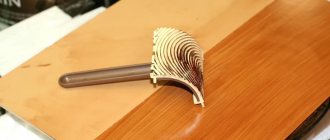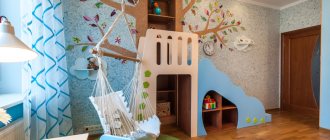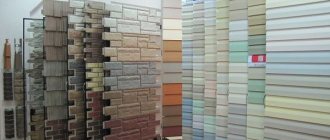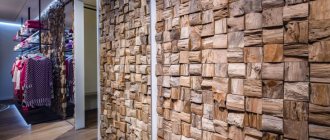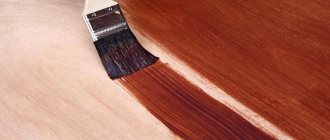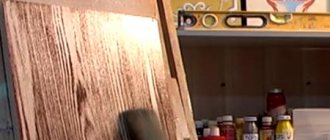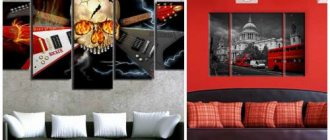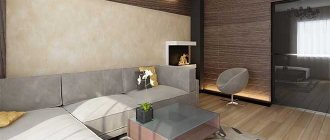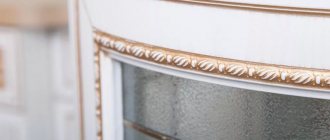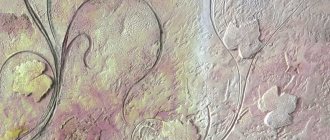/Accessories and decor/Decoration/
Topiary (“tree of happiness”, “European tree”) is a small decorative tree that decorates interiors and exteriors, and is also often used for table setting. Topiaries are good because they look very beautiful, and you can make them with your own hands in literally 1 evening from scrap materials.
- This means that you can make several decorations at once, for example, one pair for the New Year's table setting, another for the Easter table, and a couple more for the mantelpiece.
In this material you will find 1 basic instruction on how to make a topiary with your own hands for beginners, as well as 3 step-by-step master classes in addition to it and 45 photo ideas for inspiration.
Room decor made from natural materials
The technology for making a tree from branches with your own hands is very simple, but for this it is important to use high-quality and well-processed materials.
This addition is perfect for decorating a designer interior, decorating individual surfaces or furniture, and creating non-standard compositional solutions:- using branches and brushwood to decorate individual decorative items;
- production of decorative additions to existing furniture structures;
- decorating surfaces with branches and cut circles from tree trunks;
- creating unusual compositional groups using non-standard techniques.
The uniqueness of the interior composition is achieved through the use of simple technology for processing branches, which can be easily bleached and painted.
Before using such a natural material, it is necessary to carefully process all elements using sanding and polishing techniques.
Basic elements of ornamental trees
All decorative tree crafts have three main elements:
- The basis . In the final version, the base is the crown of the tree. In most cases, the base is spherical in shape. But if the topiary is made for a special occasion, then you can give the crown the shape of a heart, number or letter.
You may be interested in: How to make a chair for a doll from plastic bottles: a detailed guide with step-by-step photographs
For a spherical base, tightly crumpled newspaper or other unnecessary paper is often used, tied with thread and coated with paste.
For the shaped base, polystyrene foam, polyurethane foam, and a papier-mâché mold are used.
- Barrel . Any suitable material is used as a trunk for the “tree of happiness”: a knitting needle, rigid wire, wooden skewers, elements of some kind of structure suitable in shape.
You can also use natural sticks and tree branches. But they are first prepared: after freeing them from the bark, the branch must be washed and coated with varnish or stain.
- Pot or stand . Topiaries look more impressive if their crown diameter is larger than the diameter of the pot. It is difficult to choose a ready-made pot that fully corresponds to the idea of a decorative tree. It’s easier to take any inexpensive pot that is suitable in size and decorate it with existing materials: cover it with fabric, paint it, paste it with decorative elements, tie it with a rope. The crown, trunk and pot must form a single stylistic whole.
Depending on the idea of the decorative tree and the method of its manufacture, you may need:
- glue (superglue, liquid nails, hot glue)
- cement (gypsum, sand, alabaster) to weigh down the base and securely fix the trunk in the pot
- decorative elements: ribbons, cones, shells of various nuts, dried flowers - everything you need to realize a specific plan.
You may be interested in: Forms for pouring tiles: we make them ourselves from scrap materials
Seasonal tree
To make the decor from tree branches with your own hands look stylish and exclusively, you can form a full-fledged tree from the branches.
Such crafts are placed in wooden tubs or ceramic pots, and to complement the composition you can use various decorations that correspond to the current season.
Step-by-step master class on making topiary
To make a topiary with your own hands, first of all prepare the basic elements:
- The trunk, if it is not a natural branch, is wrapped with satin or other ribbons, twine, covered with fabric, and covered with materials selected for this composition. If the barrel consists of several elements, for example, several thin knitting needles or kebab skewers, you must first tighten them with electrical tape.
- You need to think about how to fix the tree in a pot and prepare all the necessary materials. When using a flower pot with drainage holes, it is important to seal them first. If the pot or bucket is heavy enough so that the crown does not outweigh the base, then foam plastic, pieces of polystyrene foam, or even polyurethane foam are sufficient for fixation.
The trunk in such a pot is placed in the center, sunk to the ground, burst with prepared materials and filled with polyurethane foam or alabaster in the consistency of sour cream.
To weight the pot, use cement mortar with sand: placing the trunk in the center and fixing it, pour cement into the pot and leave to harden. A tree on such a base will stand securely.
- The finished base is put on a firmly fixed trunk, or the trunk is fixed with the base already put on.
You may be interested in: DIY kitchen decor: 11 decorating ideas
If the base for the tree crown is made in the form of any figure, for reliability it should be secured with glue.
The “skeleton” of the tree is ready – you can decorate it.
The near-trunk space of the pot can be decorated with pebbles, shells, and covered with floral mesh or fabric.
The pot itself can be covered with fabric to make a beautiful paper “wrapper”.
The crown can be attached to the base using glue, flowers can be pinned with wire, or placed on wooden skewers.
Wall panels
You can place original crafts made from dry tree branches with your own hands on the walls, replacing paintings and other decorative elements with them.
Stylish and modern panels imitate the view from the window; to enhance their uniqueness, you can use lighting or wood panels to create additional visual effects.Not only aestheticism, but also functionality
Actually, branches don’t have to be just decorative – with the right approach, they can be used, without any exaggeration! Let's say you need to hang several shelves - so let them become branches in the overall structure of the tree! And it is not necessary that they be strictly horizontal - at least if they have side walls. You can store various small things there, such as books, toys or feminine accessories. A very unusual solution would be a family tree, where portraits of family members, arranged in the appropriate order, will be placed on shelves, or simply fixed on top of the picture. An example of a tree with photographs on the wall can be seen in the photo below.
A family tree can be a useful way to decorate a wall.
If real tree branches were used in creation, they can be used as a hanger for various small items. Please note! If the branches themselves are small and fragile, then they will not support heavy objects, however, say, small jewelry can be hung on them. This is especially true for ladies who have a lot of different rings, pendants, chains and other small jewelry.
Don’t limit the flight of your own creativity - try to create something unusual, and let your tree on the wall be unique!
Photo gallery: creative ideas for wood on the wall (16 photos)
Lighting devices
You can easily turn unusual items made from tree branches into practical crafts by decorating lighting fixtures with natural materials.
Note!
How to make flowers from cold porcelain: chic floristry and DIY crafts for the New Year step by step
How to make cold porcelain from potato, corn starch, liquid, without soda. Recipes and cooking methods
How to properly make a birdhouse with your own hands from scrap materials: we create an original birdhouse according to sketches
Floor lamps and table or wall lamps with lampshades decorated with bleached and varnished branches or wreaths made from them, with the addition of decorations, look original.
What's so good about this finish?
The main advantages of this type of finishing (compared to natural wood) are lower cost and greater durability. Decorative plaster for wood:
- doesn't rot
- withstands temperature fluctuations,
- resistant to precipitation,
- does not burn,
- can be renewed by coloring,
- hides minor flaws,
- "breathes"
- environmentally friendly
Holiday decor
An unusual DIY tree made from tree branches will decorate the room and serve as a wonderful addition to the overall atmosphere of the upcoming holiday.
If necessary, such products can be easily painted and covered with artificial snow, and decorated with hand-made Christmas tree decorations and garlands.
What you need to remember when decorating a tree on the wall
When forming such an interior element, you should remember the general rules:
- The wall must be free at least 0.5 m on each side of the drawing;
- If it is necessary to visually expand the space, use an image that is made schematically;
- On large areas of housing, it is possible to create realistic images, both in color rendering and in the structure of convexities.
On large areas of housing you can create realistic images.
Paintings from branches
Stylish paintings made from small twigs and natural materials can have their own artistic value and beautifully complement the interior of the room.
Several long branches connected to each other with twine will perfectly complement such a picture and will serve as a picture frame or frame for family photographs.
Note!
How to make candles with your own hands: instructions for making wax, gel, scented, homemade decorative candles with a wick
What you can make from foamiran with your own hands: we create flowers, Christmas tree decorations, snowflakes, three-dimensional paintings (photo + video)
DIY glass crafts: what can be made from glass bottles, liquid glass, broken glass (photo + video)
Painting plastic to look like wood
There is nothing difficult in carrying out this task. But in order not to spoil the material and make the coating durable, you need to know some quality characteristics of the materials:
- There are types of plastic that cannot be painted;
- after sanding, the plastic is coated with a primer;
- Some types of paints that serve as a solvent for plastic cannot be used for painting.
To achieve a perfect resemblance to wood, you should not use a roller during the painting process. It is best to use a wide, medium-hard brush.
As a result of this painting, the white color of the doors becomes the color of wood. In the interior of the room, a wooden door looks much richer and more prestigious. While maintaining the quality of plastic, the external design of the doors takes on the appearance of a wooden product.
A thin film is applied to the plastic, which imitates the pattern of wood materials. This gives the door a qualitatively new design solution, while the structure of the material remains the same. When the paint dries, it forms a durable protective layer, similar in appearance to natural wood. A good result is obtained after painting with acrylic paints and varnishes.
On video: how to paint various materials to look like wood.
Themed wreaths
Unusual wreaths, woven from rough branches and decorated with decorations with different themes, are suitable for decorating walls and entrance areas.
To make such crafts, you can use techniques of sequential and circular weaving, gluing and twisting, focusing on the overall interior design.
Tree Vinyl Decals
A ready-made version of tree images is special vinyl stickers. This is the easiest way to decorate the interior. No creative abilities are required. You just need to purchase a sticker according to your own taste and stick it on the selected surface.
The only condition is an immaculately smooth surface. The advantages of ready-made stickers include:
- Low cost.
- Easy to use. Pasting an image is so easy that even a child can do it.
- Easy care. Vinyl can be easily cleaned from dirt with a damp sponge.
- Unpretentiousness: resistance to temperature changes, humidity and UV radiation.
- A variety of options, the ability to choose an image that fits perfectly into the design of the room. It is possible to choose a pattern that perfectly harmonizes with the color scheme of finishing materials.
Techniques for processing natural materials for compositions
Making your own decor involves the possibility of pre-processing natural materials; for this, the following techniques are used:
- papering and varnishing;
- polishing and bleaching of material;
- coloring and glitter coating.
Elegant and original compositions can be further decorated with decor and decorative elements, emphasizing the style of the room.
Tree on the wall as an idea for interior decoration
Using the image of a tree, you can transform the interior. Moreover, there are different execution techniques. And this allows you to fit such decoration into any style, from ultra-modern high-tech and minimalism to classic modern.
Using the image of a tree, you can transform the interior.
In what rooms can it be used?
Regardless of the method of implementation, a composition with wood looks elegant in the following rooms:
- Living room;
- Bedroom;
- In the kitchen - where you need to fill an empty corner. A simplified Asian-style version looks good in the dining room;
- Corridor - provided there is a free corner or section of the wall not filled with furniture;
- Loggias - if the image is not filled with interior objects.
This image looks harmonious in any part of the apartment, perhaps with the exception of the bathroom or bathroom.
This image looks harmonious in any part of the apartment.
Photos of trees made from branches with your own hands
Please repost
0
Technology and application methods + video
Bark of tree
As an example of how decorative plaster with the effect of wood bark is made, let’s take a finish made from the least expensive materials.
- The working solution is prepared from gypsum plaster. The purchased dry mixture is diluted in water.
- The solution is applied to the prepared base using a trowel in an even layer of 2-3 mm.
- The initial relief is immediately applied with a roller moistened with water.
- When (after 20-30 minutes) the surface of the plaster dries a little and does not sag when pressed lightly, it is moistened with a spray bottle and the protrusions begin to be smoothed. This is done with a spatula so that after it passes between the smooth areas, ruts remain - deepening cracks in the bark. After each long smoothing movement of the spatula, wipe it with a damp cloth so that the lumps of solution remaining on it do not spoil the surface.
- The surfaces are allowed to dry completely (usually a day). After drying, small flaws that can be scratched are removed with a spatula.
Wax is usually used for the protective layer of decorative plasters. In this case, it can be replaced with non-woven glue mixed with water-soluble acrylic varnish. The glue is diluted, brought to readiness, and mixed with varnish in a ratio of 1:0.5. Then the selected color is added and after stirring, the “budget wax” can be used. It is applied with a trowel. With this application, all the depressions are filled and the surface is smoothed. Excess is removed with a damp sponge, and the surface is smoothed again with a trowel. This type of finish can be varied in various ways, for example, you can apply a little paint of a different tone with a sponge.
Application of the die
Imitation of a wood surface using a rubberized stamp is performed in the following sequence:
- Using a trowel, apply a layer of the mixture having the consistency of sour cream, 2-2.5 mm thick.
- The stamp is “dragged” without pressure along the top of the layer in a horizontal or vertical direction (depending on which direction of the main lines of the wood pattern is chosen). At the same time, the stamp itself is slightly swayed from one wide edge to another (this is why it is made convex), as a result of which the lines of the wood texture on the surface of the layer turn out to be changeable, close to the natural pattern.
- After the layer has dried, it is treated with fine-grain sandpaper - 240-320.
- Painted.
- Cover with varnish or wax.
Using a brush
The textured pattern is obtained by drawing the bristle of a brush along the main direction of the wooden lines. No pressure is required, but any solution adhering to it must be regularly removed from the bristles. The slightly dried surface is slightly smoothed with a spatula so that there are no sharp protrusions.
Using a shaped spatula
Do-it-yourself wood-look plaster can be easily done using a spatula with a serrated blade. You can make such a spatula yourself by cutting teeth on a plastic or wooden spatula with a knife. Instead, you can use half a nylon lid for jars. All the variety of lines can be obtained by moving the spatula tortuously, with some rotation of the line of the working edge relative to the line of movement of the tool.
Application of silicone matrix
Matrices for applying wood texture using the imprint method are available for sale. The silicone matrix tape can imitate a long board (it is better to work together). A short matrix is used to obtain bark impressions. In the first case, you will need an ordinary roller to roll the silicone tape to the surface.
Sequence of work:
- After applying the plaster mortar, a matrix tape moistened with water is applied to the surface of the layer,
- The tape is rolled with a roller to obtain a clear print.
- Using a wooden stick or other convenient device, grooves are drawn along the tape, simulating joints between the boards.
- The tape is carefully removed, wetted and the cycle repeats.
- The seams between the “boards” are smoothed with a damp, hard, narrow brush.
- After drying, the layer is processed with sandpaper.
Such wood-like plaster can decorate the facade, the walls of the loggia, or the hall of the room.
Making wooden panels
Wood-like plaster can occupy significant areas in the interior. At the same time, it is desirable to further diversify them. One of the techniques is to divide the area into sections with different directions of the boards - a kind of typesetting panel. To simulate seams between boards, strips of masking tape are used. The most suitable width for them is half a centimeter. The sequence is as follows:
- Before applying the solution, the wall is outlined,
- The ribbons are glued to the wall so that the ends remain, by which they can be removed after processing the panel.
- A layer of mortar (up to 0.5 cm) is applied to the wall.
- The surface of the boards is given the appropriate texture with a rubber stamp, brush or shaped spatula.
- After the layer has dried somewhat, the tape strips are removed, and the edges of the resulting seams are trimmed and smoothed with a semi-dry brush.
Performing the bark beetle effect
The structural composition is applied to the surface of the wall with a trowel in an even layer. The layer is allowed to set a little and with a grater, rolling the granules, a bark beetle pattern is applied. Uneven protrusions are smoothed with a clean spatula or trowel. After the finish has dried, its surface is cleaned with sandpaper and the dust is removed.

